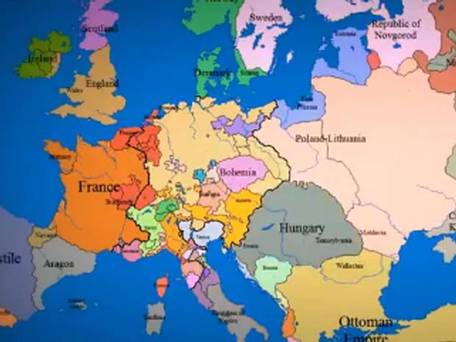
Video: Crimea just a blip? 1000 years of Europe’s history in three minutes
March 20, 2014
Glasgow 2014 is much more than two weeks of sport
March 21, 2014WASHINGTON — European nations are begging the United States to send them natural gas to blunt dependence on Russia, but a lack of infrastructure and market realities are calling into question America’s ability to flex its new muscles as the world’s leading energy power.
The crisis in Ukraine is deepening European alarm over reliance on Russian energy, a weapon that Russian President Vladimir Putin uses to wield economic and political power. Western nations have begun imposing minor sanctions on Russia but aren’t hitting Putin where it really hurts, the energy trade, because Europe relies on Russia for some 30 percent of its natural gas and needs the energy.
Some congressional Republicans claim the key to countering Putin lies beneath Americans’ feet. The United States is in the midst of an oil and gas boom fueled by “fracking” _ a mining process called hydraulic fracturing _ and has overtaken Russia as the world’s top natural gas producer. But little of that American natural gas is sent abroad.
Rep. Cory Gardner, R-Colo., is pushing a bill to accelerate federal approval of export terminals, saying it would unlock U.S. natural gas supplies “to help free Ukraine and other European nations from Russia’s influence.” House Speaker John Boehner, R-Ohio, argues that Putin is happily exploiting the lack of U.S. natural gas exports in order to finance his geopolitical ambitions.
But while calls for such a Berlin-airlift-style approach to rush American natural gas to Europe and liberate it from the Russians makes for a good political sound bite, such a move isn’t practical and vastly oversimplifies the issue. It would take years to build the necessary facilities on both sides of the Atlantic for shipping and receiving the liquefied natural gas. The countries most reliant on Russian energy, including Ukraine, have no terminals for receiving LNG tankers. They get their natural gas from pipelines.
“The potential in the short term is nothing,” said Edward Chow, an energy and security analyst at the Center for Strategic and International Studies.
There are also the realities of the free market. The U.S. Department of Energy has so far approved six applications for natural gas export terminals, but most of that gas is destined for Asia, where prices are far higher and companies can make more money than selling it in Europe.
Longer term, it’s not clear how price-competitive U.S. liquefied natural gas would be in Europe after the cost of transport is factored in, said Tim Boersma, an energy expert at the Brookings Institution in Washington. The American natural gas in Europe would have to compete against supplies from places such as Russia, Norway, Algeria, even the Netherlands and the United Kingdom.
“There’s no assurance the natural gas would go that way anyway given how high (natural gas) prices are in Asia,” said John Kilduff, a veteran analyst at energy trader Again Capital in New York. “That’s not a well-supplied global market, either.”
American natural gas exports still could diminish Russian power, however, even if those exports go to Asia and not Europe, according to Elizabeth Rosenberg, director of the energy security program at the Center for a New American Security.
That’s because it could lead other countries that would otherwise ship to Asia to send natural gas to Europe instead. For example, it could make sense for Middle Eastern and African nations to get more involved in the European market in the face of competition from U.S. energy exports to Asia. Any non-Russian natural gas that goes to Europe lessens Russia’s ability to dictate the price.
The crisis in Ukraine is already accelerating European efforts to get away from Russian natural gas, Rosenberg said. Poland is especially pushing to develop its own shale gas through fracking, and last week it offered six-year tax breaks to speed exploration and reduce its reliance on Russia.
Ukraine also is home to substantial shale gas reserves and has deals with Chevron and Shell in an effort to develop them.
Coal, much of it from America, also is growing in favor in Europe. European power plants could upgrade their technology and install dual-use boilers that would allow them to generate electricity from imported coal as well as natural gas. That would be attractive to coal exporters in both the United States and its rival coal-mining nation, Australia.
“It’s a much more polluting product, and it will make the Europeans nervous, but that is the only readily available alternative over the next few years,” said Patrick Clawson, a sanctions and energy expert at the Washington Institute for Near East Peace.
Exports of U.S. bituminous coal totaled 117 million tons last year, after rising to 125 million tons in 2012. Both years were well above historical averages, and Europe is the top destination for U.S. coal exports, much of it going to the Netherlands and Italy.
Russia has the advantage of a well-established pipeline network into Europe, but it stands to suffer greatly if Europeans do manage to come up with alternative energy sources.
Russia depends on Europe for 90 percent of the natural gas export revenues that it badly needs, said Chow, the analyst at the Center for Strategic and International Studies.
“So who has got leverage on whom?” he asked.
Email: scockerham@mcclatchydc.com; Twitter: @seancockerham. Email: khall@mcclatchydc.com; Twitter: @KevinGHall.
